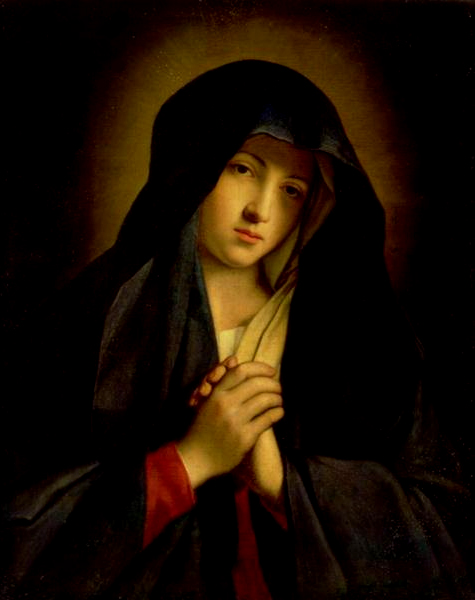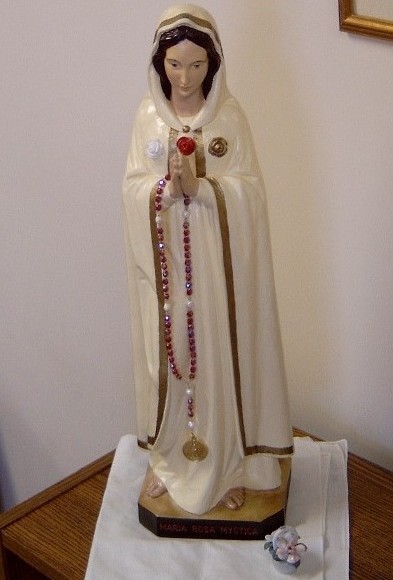Mary, my Mother, thanks for this day. I enjoyed the Rosaries
we prayed in front of the Rosa Mystica statue and the procession that followed.
The ambience provided by Nature – the green paddy field, the white birds (egrets), the elongated
pond and even that big butterfly with its black and yellow wings hugging those red shoe flowers - really made me think of your apparitions in
Cova da Iria, Lourdes, Medjugorje hills and of course, the little village of Montichiari with its suburb Fontanelle I enjoyed praying the Litany – four times!!! – as I have never done before!
Though the candle in my hands blew off in the wind, the flame that you lit in my
heart still remains fresh. Thank you dear Mother for this wonderful day! Today
is the feast of the Exaltation of the Holy Cross of Your Beloved Son. How
blessed do I feel to have spent this day at your feet.
Let me here mention one of my favourite websites, where we can view the beautiful illustrations and explanations of the Litany of Loreto.
http://campus.udayton.edu/mary/prayers/rosamystica.html, Let me quote from this site here :
The Marian Library has in its possession rare books of the eighteenth century with engravings by the renowned Augsburg artist, Josef Sebastian Klauber (ca. 1700-1768). The highly symbolic and illustrative reproductions are typical of the Baroque period. Their message is of great spiritual riches. Mary's profile is that of the exalted Mother, Virgin, and Queen, as suits the period. We limited ourselves to the illustrations of the Marian titles. The reader needs to keep in mind that the titles introduced in the nineteenth and twentieth centuries, obviously, are not included in Klauber's illustrations.Below is the illustration of Mystical Rose and its explanation
 Rosa Mystica
Rosa Mystica
Mystical Rose
Mary is compared to the mysterious (mystical) rose. The rose was symbol of mystery (antiquity), and for early Christians a metaphor of both martyrdom (Cyprian) and paradise (catacombs of Saint Callistus). The half image of Mary in this illustration emerges from a giant rose bush planted in a French garden. Two potted rose trees flank the central image. All three serve as visual support to the scriptural references of the rose symbolism applied to Mary.
The rose bush with open petals serving as throne of Our Lady bears the following caption: “Open up your petals like roses planted near running water” (Sirach 39:13). The lateral rose trees make reference to the “rosebush in Jericho” (Sirach 24:14) and to the “blossoms on the branches in springtime” (quasi flos rosarum) (Sirach 50:8). The immediate reference of these three rose metaphors is the children of God, Wisdom, and Simon, Son of Jochanan. They are also applied to Mary in order to highlight Mary’s sinlessness and role in the Incarnation. Indeed, she is “rose without thorn” (since Sedulius Caelius, ~ 430) and the shoot (Mary) of the root (Jewish people) from which a “bud shall blossom” (Jesus) (see Isaiah 11:1 – since Tertullian, Ambrose). Mary’s mystery is that of her virginal motherhood. The invitation of the lemma: “Let us crown ourselves with rosebuds” (Wisdom 2:8) is addressed to all. We are called to be sons and daughters of God.
Mother dearest, tomorrow is your feast , the feast of your
Seven Dolors.
Hail, Mater Dolorosa

Let me pray the last verses of Stabat Mater here:
Be to me, O Virgin, nigh,
lest in flames I burn and die,
in His awful Judgment Day.
lest in flames I burn and die,
in His awful Judgment Day.
Christ, when Thou shalt
call me hence,
be Thy Mother my defense,
be Thy Cross my victory;
be Thy Mother my defense,
be Thy Cross my victory;
While my body here decays,
may my soul Thy goodness praise,
Safe in Paradise with Thee.
may my soul Thy goodness praise,
Safe in Paradise with Thee.


Dear sir
ReplyDeleteI am looking for rosamistica statue please let me know
My email id kuriakosemanuja@gmail.com